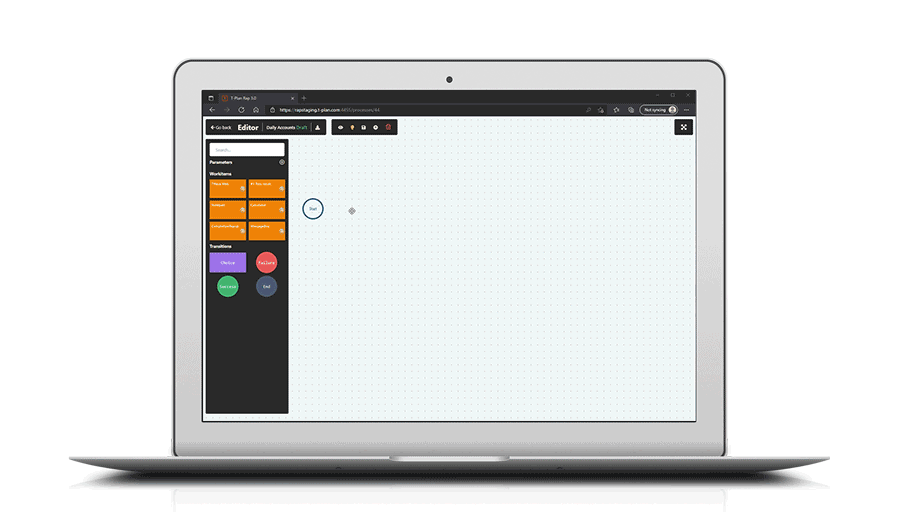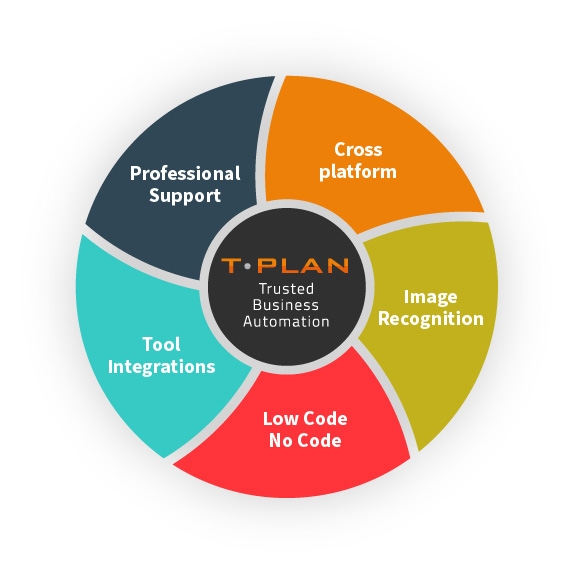Non-Intrusive Automated Black Box Testing Tool
Validate software from an end-user perspective without requiring access to sensitive source code.

T-Plan Robot fully supports black box testing methodologies, optimises your software testing process and ensures superior application quality.
Non-Intrusive – No Source Instrumentation
Test your applications without the need for access to the underlying source code.
Any device,
any OS
A single platform for cross-browser, cross-device and cross-operating system (OS) testing
Increase quality
at scale
Expand testing at speed with parallel and out of hours testing whilst increasing quality with tighter controls and improved insights
Save on time,
speed up releases
Save on average 1 day per week per tester helping you hit the market quicker with your latest release
Get a FREE demo today
Cross-Platform Support:
By their very nature of being non-intrusive, Black Box testing tools tend to support multiple platforms for different devices.
selecting tools that could perform the core functionalities of mobile applications as per business specifications. The tool should not only mirror the user experience but should also be agile in usage.
Image-based automation tools analyse images of the application or the whole computer desktop. They get the images usually from the underlying operating system, for example from the desktop image buffer or through attaching to the graphic driver. Advantage of this approach is that the underlying technology is irrelevant and the tool can automate any application that displays on the desktop of the operating system. Such automation is close to the end-user experience, easy to develop and learn without programming experience. It can also reveal layout problems in testing projects such as overlapping or ill-fitting GUI components.
T-Plan Robot Enterprise is an image-based automation tool. Due to the nature of the way it performs the automation of the system, the tool itself in the industry is termed a Black Box Automation Tool. In essence, Robot provides image comparison methods, allowing to search for GUI or text components on the desktop, and verify the status of the tested application, by comparing against collected image templates or applying actions to these found components to drive workflow in RPA projects.
Image-based automation is termed within the industry as “Black Box” given its nature of applying the user input and verifying or applying the graphical (application) output. Black Box automation does not get involved with what occurs in between these two events in terms of how they are processed by the applications, what code branches were executed, object properties, etc. – this would be otherwise known as “White Box” automation.
As T-Plan Robot interacts in this way, it connects to the SUA (system under automation) via the input (mouse/keyboard) event queue and the display image buffer. This is achieved primarily through the use of VNC (Virtual Network Computing) for connections to secondary machines or using the direct Java and OS API’s for the local operating system in a local desktop setup.
By comparing the displayed screen against a set of predefined image templates we can determine that the system is fit for purpose in the realms of UAT (User Acceptance Testing), or drive user actions for Robotic Process Automation (RPA). The key point here is that T-Plan Robot does not “see” the code of your application, which is never seen by the user, but instead what is delivered to the user via the screen.
Black and White Box testing
Black and White Box testing are very common testing terms and should be familiar to all testers. In general low level testing such as Unit or Link testing will use White Box test techniques whereas testing performed later in the SDLC will tend to use Black Box techniques.
There are a number of different techniques that are applied to Black and White Box testing. Some of these are complex and difficult to understand. In essence, Black Box testing is concerned with whether the application works as specified without knowing how it does it. White Box testing however does look at how it works and is focused at a much lower level.
Black Box test techniques
Black Box test techniques look at a component or a system from the point of view of ‘What’ it does rather than ‘How’ it does it. If the expected result is validated by the actual result then the test passes regardless of how that result was arrived at.
An image-based testing tool at its core
Image-based automation tools analyse images meaning the underlying technology is irrelevant and the tool can automate any application that displays regardless of device, operating system or browser. By comparing the displayed screen against a set of predefined image templates we can determine that the system is fit for purpose in the realms of UAT (User Acceptance Testing), or drive user actions for Robotic Process Automation (RPA).

Why chose T-Plan Robot for your Black Box Automated Testing?
Real browsers,
any device
Unlike any other tool on the market, T-Plan Robot can automate across any OS and access real browsers and devices for live automated testing
No code or
low code
No need to type a single line of code using T-Plan’s intuitive UI supporting codeless drag & drop script development alongside our capture and playback recorder
Comprehensive Test
Coverage
T-Plan Robot covers all aspects of your software, including the user interface, functionality, and integration with external systems.
Scalable and
Flexible
T-Plan Robot seamlessly manages large-scale black box testing, meeting evolving software quality assurance needs from small applications to complex enterprise systems.
Automates every aspect at screen level
Working intuitively at the screen level, business analysts can help testers drive testable paths through the application
Cost-Effective
Solution
By automating the testing process, you can achieve faster time-to-market, reduce the risk of software defects, and minimise the need for manual intervention.
Non-Intrusive Testing
Capabilities
By validating your software's behaviour and functionality from an end-user perspective, it ensures compliance with desired specifications and user expectations.
External data
Integration
Automation events driven by data feeds from various formats including spreadsheets, databases, pdf’s, text files etc. Ability to communicate and use live data at any point in the automation cycle through APIs and web requests.
Support at every stage
Extensive Training & Learning Centre
Online workshops tailored to your key objectives
Live chat
support
Frequent product updates & new feature releases
Platform Agnostic, Seamless Integration
Integration Capabilities
Integrates with a wide spectrum of tools, including Selenium.
Object Automation support proven to save time, effort and money building and maintaining the Selenium testing framework.
Platform Agnostic
Automates GUI testing seamlessly across web and mobile platforms, supporting both Mac, Windows, and Linux environments with unified application, code, and file compatibility.
Image Recognition
Providing essential user feedback directly from the end-user’s perspective. Validated based on what you observe, not solely on the code’s output.
No-Code Access Required
An intuitive user interface designed for both technical and non-technical users, featuring drag-and-drop functionality.
